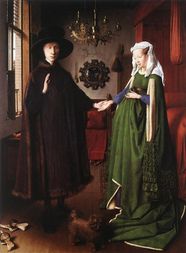|
|
Post by toonMom on Jan 28, 2005 6:59:43 GMT -5
That's what my Art History teacher says anyway. I love art history and I'm hoping to spark some interest in at least one of you here. The guy I'm talking about is Jan van Eyck. His paintings are amazing works of art with tremendous details. I want to show you just the one, which blew me away. It's called " Arnolfini Marriage"  Above is the painting in it's entirety. The dog represents fidelity and love. The one candle burning above in the chandelier can be interpreted as the nuptual flame, or the eye of God. There's more, but you get the idea. Jan van Eyck was the first painter to include nature in his work. The only way he felt he could do this is by including hidden meaning in all the objects. Every little object in the painting has some sort of spiritual meaning. Now, on to the good part...  The mirror, which rigth at the focal point of the painting is the size of a quarter. You can't really see the detail here, but the cirlces around the outside are the stations of the cross. If the whole thing is the size of a quarter, how small are those 10 little pictures. It's hard to see it here, put you can see what is happening in each little painting. That's it for me. I hope someone found this interesting. If you want to see more, this is a great site: Jan van EyckIf you click on the i to the right, you'll get a page with information about the painting. |
|
|
|
Post by donpinsent on Jan 28, 2005 7:31:05 GMT -5
also interesting: in the reflection in the mirror, you can see the backs of the couple, then beyond them the priest marrying them, then beyond him, what is believed to be van eyck himself painting the whole scene! now that's detail!
|
|
|
|
Post by nelsonsantos on Jan 28, 2005 20:45:04 GMT -5
|
|
|
|
Post by dedder on Jan 31, 2005 14:06:16 GMT -5
well, after all, it was a Belgian....  |
|
|
|
Post by itsadam on Jan 31, 2005 15:35:32 GMT -5
WOW. That guy really put a lot of detail in. I can only imagine the amount of hours took on that.
|
|
|
|
Post by nelsonsantos on Jan 31, 2005 15:53:50 GMT -5
I imagine more months!!!!!
|
|
|
|
Post by corky on Feb 8, 2005 20:10:12 GMT -5
I'm taking Art History, and we just finished talking about Van Eyck and the Late Gothic period. I admire the detail of his work, but I thought it was Brueghel the Elder who first painted nature (landscape) as the main subject of his work. Did you mean something different than landscape? I was told that it was the High Renaissance period where nature became the subject and not just the background. Did you mean natural? Coz that's evident in Van Eyck's work...with a little bit of idealization thrown in. I love the brilliant colours of the palette!
I love seeing how art has developed over the centuries and where it's leading us today. I find it amazing to think that these artists spent years of their life learning and practising art!
|
|
|
|
Post by toonMom on Feb 8, 2005 21:03:02 GMT -5
I meant nature. Prior to van Eyck, nature was not included at all. There were just people and that was it. Nature was thought to be evil and was looked down upon. I don't mean nature as in landscapes, but as included in his work.
We just learned about Altdorfer, who we were told was the earliest pure landscape artist. I believe he founded the Danube school, which focused on landscape painting.
We haven't gotten to Bruegel yet, that should be next week.
This is what I was taught anyway, could be inaccurate?
|
|
|
|
Post by corky on Feb 14, 2005 21:48:36 GMT -5
I'm just a bit confused about the information you've been given, and what I've been told. I guess art is wide open to interpretation, of course...I haven't learned about Altdorfer, but we've talked about Brueghel being one of the most significant painters of genre style (painting ordinary people, and making the landscape more important than the figures). We talked about Naturalism in Van Eyck's paintings, as it was a very important element in Late Gothic. Naturalism is different than nature...naturalism is portraying the people as objectively and accurately as possible, without idealizing them.
Whatever instructors are saying about this piece, it is beautiful and loaded with symbolism. I just need to remember it all for my exam next week...
|
|